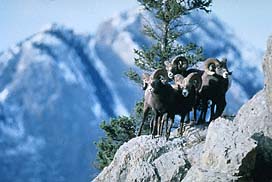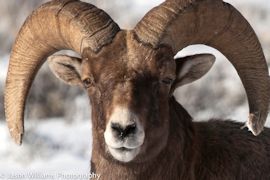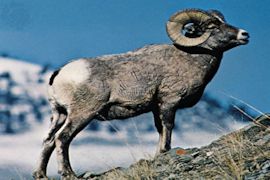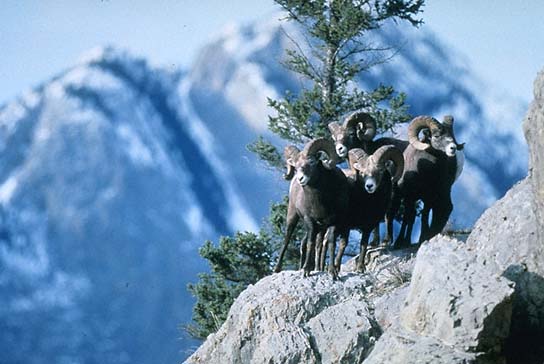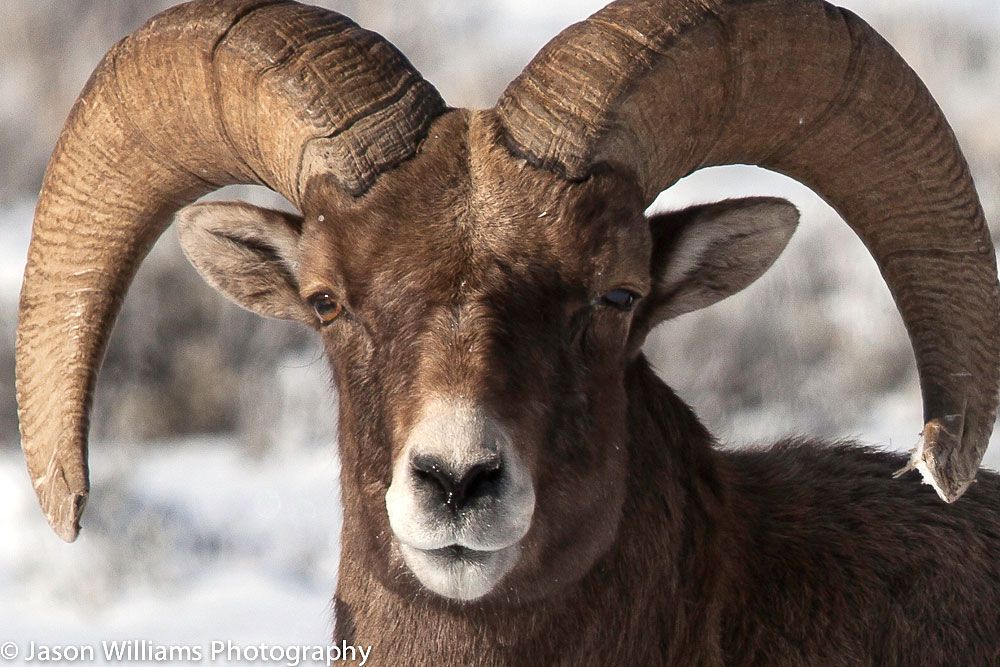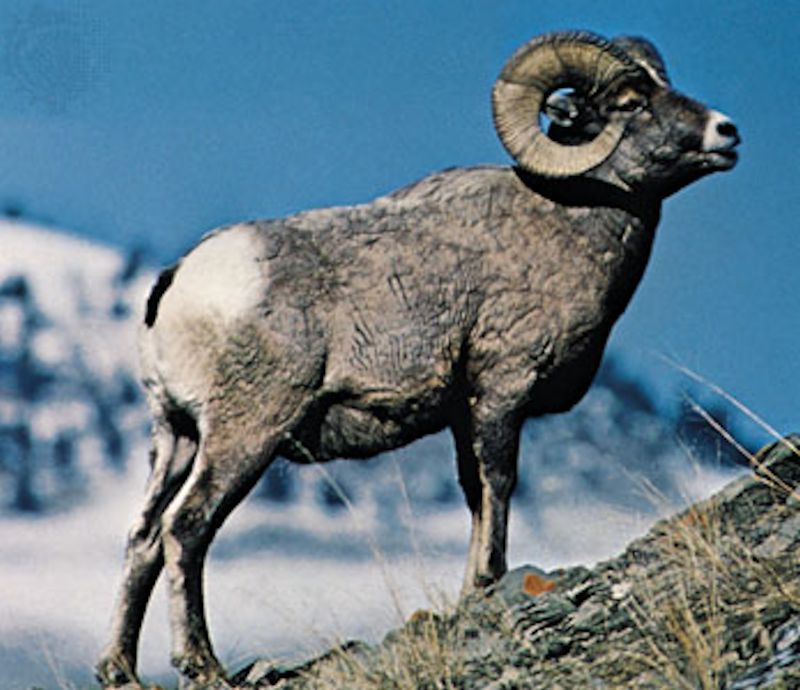Hoofed Mammal
Description
A medium-size bovid. Muscular body, with thick neck. Color varies from dark brown above in northern mountains to pale tan in desert; belly, rump patch, back of legs, muzzle, and eye patch are white. Short, dark brown tail. Coat sheds in patches June–July. Ram has massive brown horns that curve up and back over ears, then down, around, and up past cheeks in C-shaped "curl"; spread to 33" (83 cm). Ewe has short, slender horns that never form more than half-curl. Juvenile has soft, woolly, creamy-fawn coat. Ht male 3'–3' 5" (90–105 cm), female 30–36" (75–90 cm); L male 5' 3"–6' 1" (1.6–1.85 m), female 4' 2"–5' 2" (1.28–1.58 m); T male 4–6" (10–15 cm), female 3 1/2–5" (9–13 cm); HF 12–220 (27.6–48.2 cm); Wt male 127–316 lb (58–143 kg), female 74–200 lb (34–91 kg).
Endangered Status
The Bighorn Sheep is on the U.S. Endangered Species List. It is classified as endangered in California. Both the Peninsular Ranges population in the U.S. and a California subspecies called the Sierra Nevada Bighorn are protected under the Endangered Species Act. These animals began their decline in the mid-1800s at the time of heavy human settlement of the West. This can be attributed at least in part to degradation of their habitat due to development, road-building, water-management practices, and recreational activities. The bighorns have also been affected by disease, sometimes passed on to them by domestic sheep, and are often preyed upon by Mountain Lions and probably by domestic dogs as well. These sheep live in increasingly fragmented populations, which makes them vulnerable because a single event, such as an illness, can wipe out an entire population.
Sign
Bed: Depression about 4' (1.2 m) wide, up to
1' (.3 m) deep, usually smelling of urine, almost always edged with
droppings.
Scat: Dark pellets, usually bell-shaped, sometimes
massed if vegetation is succulent.
Trails: Similar to that of
Mountain Goat or deer, but at elevations higher than deer trails and
on slopes less precipitous than Mountain Goat trails. Shed or
snagged hair, longer and generally darker than deer and Mountain
Goat hair, may help identify trail.
Tracks: Double-lobed prints,
3–3 1/2" (75–90 mm) long, with hindprints slightly smaller than
foreprints; similar to deer’s but with straighter edges—less pointed
and often more splayed at front, and less heart-shaped. When walking
downhill on soft ground, dewclaws may print 2 dots behind hoofprint.
Walking gait about 18" (450 mm); bounding gait on level ground 15'
(4.5 m), down steep incline 30' (9 m).
Discussion
The Bighorn Sheep inhabits areas around rocky cliffs rarely disturbed by humans. It perhaps has adapted to this rather inhospitable habitat because there is a lack of competition as well as protection from predators. A good swimmer and an excellent rock climber and jumper, this animal has hooves that are hard at the outer edge and spongy in the center, providing good traction even on sheer rock. The Bighorn is active by day, feeding in early morning, midday, and evening; it lies down and chews its cud at other times and retires to bedding spots for the night. In heavily congested areas such as Yellowstone National Park, this animal has sometimes had to resort to feeding at night. The Bighorn has a home range, but not a territory. It migrates between high slopes in the summer and valleys in winter, traveling distances of 1/2 to 40 miles (.8–64 km); it also makes minor movements, depending on local conditions. Most of the year is spent on the summer range. Highly gregarious, the Bighorn lives in herds or bands, usually of about 5 to 15 animals, including ewes, lambs, yearlings, and two-year-olds; the dominant ewe is the leader. Ram bands usually number two to five. In winter, when ewe herds join, there may be as many as 100 animals, all led by an old ewe. In spring, rams band together and move to separate higher summer ranges. As the fall rutting season approaches, rams have butting contests, which increase in frequency as the season progresses. They charge each other at speeds of more than 20 mph (32 km/h), their foreheads crashing with a crack that can be heard more than a mile away, often prompting other rams to similar contests. Butting battles may continue as long as 20 hours. Horn size determines status; fights occur only between rams with horns of similar size. (A seven- or eight-year-old ram may have a full curl, with tips level with the horn bases; a few old rams exceed a full curl, but often horns are "broomed"—broken off near the tips or deliberately rubbed off on rocks when they begin to block the ram’s peripheral vision.) With nose elevated, head cocked to one side, and upper lip curled, the rutting male follows any female in heat; if more than one ram follows the same ewe, they stop occasionally for butting jousts. The species is polygamous; dominant ram does most of the courting and mating. The male moves between herds seeking females in heat. When he finds one, the female will initiate a chase, or he will kick her in an attempt to initiate a chase, which may culminate in mating. If one male tires of mating, another will replace him. Lambing areas are on the most inaccessible cliffs. A single well-developed lamb is born with a soft, woolly, light-colored coat and small horn buds; within a day, it can walk and climb nearly as well as its mother. The lamb remains hidden the first week, then follows its mother about, feeding on grasses, and is weaned at five to six months.In summer, the Bighorn feeds mainly on grasses and sedges, particularly bluegrass, wheat grass, bromes, and fescues. In winter, it feeds more on woody plants, such as willow, sage, and rabbit brush. Favored forbs are phlox, cinquefoil, and clover. Because of dry conditions, in the desert this animal feeds more on brushy plants, such as desert holly, and on various species of cactus. Like other hoofed mammals in our range, the Bighorn beds down wherever it happens to be each night. Old beds may be reused, but they are pawed out more deeply. Bedding spots are often found along ridges, but sometimes they are in caves or in sites formed by Grizzly Bears digging for ground squirrels. Bighorns respond to disturbance by (1) assuming an attention posture—standing and staring at the source; (2) assuming an alarm posture—snorting, pawing the ground, bowing their heads, or, in the presence of wolves, huddling in a tight circle, facing outward; or (3) running, if startled at close range. Life span is about 15 years. Predators include Mountain Lions, golden eagles, wolves, Coyotes, bears, Bobcats, and Lynx; on cliffs, the Bighorn easily escapes all but the first two, and the eagles attack only lambs. The Bighorn has always been prized for its meat; the horns were used by the Shoshone and Gros Ventre tribes to make powerful bows and are still prized by hunters as trophies.

